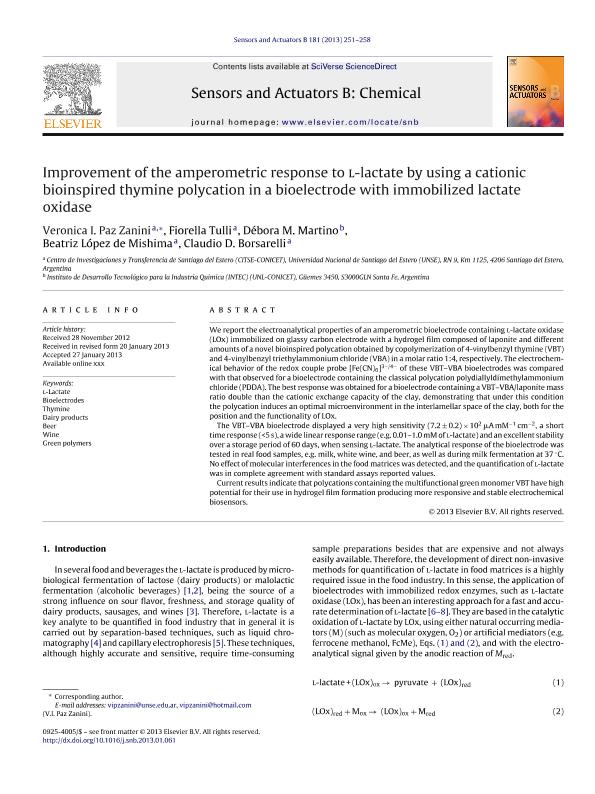Artículo
Improvement of the amperometric response to l-lactate by using a cationic bioinspired thymine polycation in a bioelectrode with immobilized lactate oxidase
Paz Zanini, Veronica Irene ; Tulli, Fiorella Giovanna
; Tulli, Fiorella Giovanna ; Martino, Debora Marcela
; Martino, Debora Marcela ; Lopez, Beatriz Alicia
; Lopez, Beatriz Alicia ; Borsarelli, Claudio Darío
; Borsarelli, Claudio Darío
 ; Tulli, Fiorella Giovanna
; Tulli, Fiorella Giovanna ; Martino, Debora Marcela
; Martino, Debora Marcela ; Lopez, Beatriz Alicia
; Lopez, Beatriz Alicia ; Borsarelli, Claudio Darío
; Borsarelli, Claudio Darío
Fecha de publicación:
01/2013
Editorial:
Elsevier
Revista:
Sensors And Actuators B: Chemical
ISSN:
0925-4005
Idioma:
Inglés
Tipo de recurso:
Artículo publicado
Clasificación temática:
Resumen
We report the electroanalytical properties of an amperometric bioelectrode containing L-lactate oxidase (LOx) immobilized on glassy carbon electrode with a hydrogel film composed of laponite and different amounts of a novel bioinspired polycation obtained by copolimerization of 4-vinylbenzyl thymine (VBT) and 4-vinylbenzyl triethylammonium chloride (VBA) in a molar ratio 1:4, respectively. The electrochemical behavior of the redox couple probe [Fe(CN)6]3-/4-of these VBT-VBA bioelectrodes was compared with that observed for a bioelectrode containing the classical polycation polydiallyldimethylammonium chloride (PDDA). The best response was obtained for a biolelectrode containing a VBT-VBA/laponite mass ratio double than the cationic exchange capacity of the clay, demonstrating that under this condition the polycation induces an optimal microenvironment in the interlamellar space of the clay, both for the position and the functionality of LOx. The VBT-VBA bioelectrode displayed a very high sensitivity (7.2 ± 0.2) × 102 A.mM-1.cm-2, a short time response (<5 s), a wide linear response range (e.g. 0.01-1.0 mM of L-lactate) and an excellent stability over a storage period of 60 days, when sensing L-lactate. The analytical response of the bioelectrode was tested in real food samples, e.g. milk, white wine, and beer, as well as during milk fermentation at 37 °C. No effect of molecular interferences in the food matrices was detected, and the quantification of L-lactate was in complete agreement with standard assays reported values. Current results indicate that polycations containing the multifunctional green monomer VBT have high potential for their use in hydrogel film formation producing more responsive and stable electrochemical biosensors.
Palabras clave:
L-Lactate
,
Bioelectrodes
,
Thymine
,
Dairy Products
,
Wine
,
Beer
,
Green Chemistry
Archivos asociados
Licencia
Identificadores
Colecciones
Articulos(CCT - NOA SUR)
Articulos de CTRO.CIENTIFICO TECNOL.CONICET - NOA SUR
Articulos de CTRO.CIENTIFICO TECNOL.CONICET - NOA SUR
Articulos(INQUINOA)
Articulos de INST.DE QUIMICA DEL NOROESTE
Articulos de INST.DE QUIMICA DEL NOROESTE
Articulos(INTEC)
Articulos de INST.DE DES.TECNOL.PARA LA IND.QUIMICA (I)
Articulos de INST.DE DES.TECNOL.PARA LA IND.QUIMICA (I)
Articulos(SEDE CENTRAL)
Articulos de SEDE CENTRAL
Articulos de SEDE CENTRAL
Citación
Paz Zanini, Veronica Irene; Tulli, Fiorella Giovanna; Martino, Debora Marcela; Lopez, Beatriz Alicia; Borsarelli, Claudio Darío; Improvement of the amperometric response to l-lactate by using a cationic bioinspired thymine polycation in a bioelectrode with immobilized lactate oxidase; Elsevier; Sensors And Actuators B: Chemical; 181; 1-2013; 251-258
Compartir
Altmétricas



